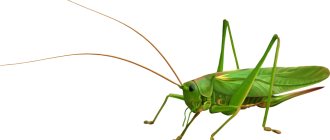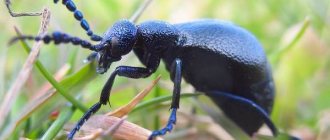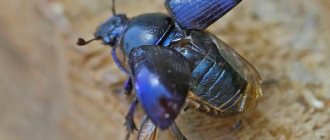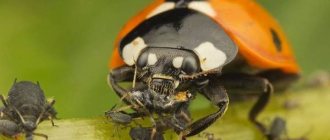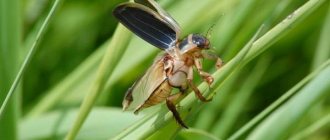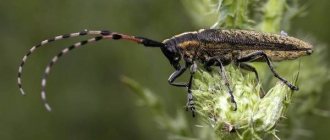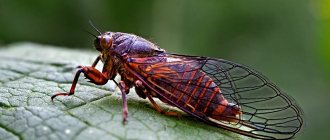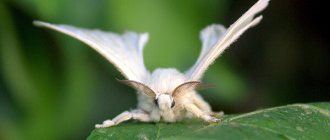The grasshopper photographs presented at Mikrul can be used as demonstration material in biology (zoology) lessons in 7th grade when studying the topic “Insects. Orthoptera."
What are the advantages of the photographs presented? In their clear image. If in a textbook for 7th grade the photographs are, as a rule, “separated” from the drawings (or diagrams) attached to them, so you have to constantly look from the drawing to the photograph and back, here everything is simpler. Firstly, the object is natural. Secondly, there is no need to run your eyes around (look for an explanatory text or diagram). Everything is nearby! Thirdly, on some slides there is also a magnification (120 times) of the organs being studied, which makes it easier to navigate through other frames.
We do not set ourselves the task of revealing the external structure as in-depth material. We simply give an explanation of where it is located and what this or that organ is. Why is that? When looking at a photograph (without a designation), naturally, as a rule, two questions arise: what is it and what is it called? Without receiving an answer to them, other questions naturally disappear, and along with them, interest in studying disappears. How does notation photography work? Let’s look at the example of the “Grasshopper Head” frame. The first thing your eye goes to is the lower right corner. This is where the attracting (currently unknown) object is located. But if “upper and lower lips” are somehow still clear (that this is a mouth), then what are “mandibles”? You are not interested in what the “mandibles” are made of, what they are covered with (or not covered with), what work (function) they perform, etc., all this comes later. In the meantime, the question is - what is it? Here under the photo is the answer: “The mandibles are the main part of the gnawing mouthparts; the first pair of jaws used for gnawing and crushing food.” Interest satisfied. And so on for each organ. You can’t do that in a book, but here you can. Next, what are those big “bumps” on the top of the grasshopper’s head? Signed: “compound eyes.” That the eyes are understandable, but what does “faceted” mean? Here is the entry under the frame - “Facet - a separate ocellus of the compound eye of arthropods consists of the cornea, lens and nerve cells.” This process of getting to know each other, or learning (whatever you like), goes through all the personnel.
We believe that at the first stage, familiarization with the external structure (in this case of a grasshopper, and in the future other representatives) will allow the teacher to remember the necessary material more deeply.
When studying the order Orthoptera, we recommend using photographs from Mikrula. In particular, all parts of the grasshopper's head are very clearly visible. The head has a separate apex of the crown, compressed laterally.
External structure of a grasshopper's head
The head is the anterior section of the body of insects, consisting of several segments fused together into one whole. The number of segments that make up the head may vary.
The mouth opening is surrounded by oral organs.
Oral organs - organs located in the oral cavity, in particular, those limbs of arthropods that are located near the mouth and are related to grasping, accepting, tearing and generally preparing food. The oral organs are covered above and below by the plates of the upper and lower lips. The upper jaws are used to capture and crush prey. The lower jaws and lower lip each bear a pair of palps, which are organs of touch and taste.
Palps are segmented appendages of the jaws equipped with various sensory organs.
The mandibles are the main part of the gnawing mouthparts; the first pair of jaws used for gnawing and crushing food.
Antennae (antennae) are mobile, thin, jointed appendages on the head of arthropods that are organs of smell and touch.
Compound eyes are compound eyes, the paired organ of vision of insects, crustaceans and some other invertebrates; formed by numerous individual eyes ommatidia. They perceive moving objects well and provide a wide field of view. Visual acuity and the ability to perceive the shape of an object are poorly developed.
Facet (ommatidium) is a separate ocellus of the compound eye of arthropods; consists of the cornea, lens and nerve cells.
In addition to the compound eyes, vision is ensured by the joint work of simple ocelli. With the help of eyes that operate in low light, the animal is able to return to its shelter before darkness sets in.
The olfactory organs (olfactory hairs and pits) are remarkable in that they can perceive odors over long distances through the air.
The presence of hairs on an animal's body is of no little importance. With the help of special hairs, some insects perceive the slightest shaking of the soil. Grasshoppers are sensitive to soil vibrations and can respond to vibrations of ground particles with an amplitude equal to 0.5 the diameter of an atom. Such sensitivity means that if an earthquake with a magnitude of 5-6 occurred somewhere in the Far East, then a grasshopper in the Moscow region would feel these soil vibrations. Therefore, the biological significance of hairs is to ensure survival. This explains the instinctive concern of each individual for the sanitary condition of the hairs. By observing insects, you can be convinced that they very diligently and repeatedly clean their hairs from dirt, using their paws, palps, and jaw appendages.
The organs of touch (sensitive hairs on different parts of the body) help to navigate even in the absence of light.
The taste organs are similar to the olfactory organs and are associated with the chemical sense.
Grasshoppers feed mainly on flowers and buds, as well as insects found among the grass. On this occasion, we can quote an excerpt from Pavel Marikovsky’s book “To a Young Entomologist”: “...Here, near a mountain stream, on the edge of a large leaf sparkling in the sun, sits a large grasshopper, tettigonium caudata. he gnaws at the greens, and his jaws work regularly and rhythmically. But a motley butterfly flew onto the leaf and trustingly opened its wonderful, gilded wings. The grasshopper's jaws stopped, its long antennae froze, and its large eyes, frozen, stared straight at the butterfly. Then an instant jump - and a minute later there was nothing left of the lovely butterfly, except for a pitiful, crumpled lump, disfigured by a predator...”
Locust invasion
Has a swarming phase in the family Acrididae. The formation of a swarm is a response to numbers. Increased tactile stimulation of the hind legs causes an increase in serotonin levels. This causes the grasshopper to change color, feed more, and reproduce faster.
The transformation of a single individual into a swarming one is caused by several contacts per minute over a short period of time.
After this transformation, under suitable conditions, dense nomadic bands of flightless nymphs known as "funnels" form. They secrete pheromones that attract insects to each other.
With several generations per year, locust populations can develop from local groups into huge swarms of flying insects known as plagues.
Devours all vegetation it encounters. The largest recorded locust swarm was formed by the now extinct Rocky Mountain locust in 1875.
It was 2900 km long and 180 km wide. Quantity – 3.5 trillion. Adult desert locusts eat about 2 grams of plant material each day. Billions of insects are very destructive, destroying all plant foliage, stems, flowers, fruits, seeds, bark.
Front leg of a grasshopper
Each leg has four sections: coxa, swivel, femur, tibia, and tarsus.
The coxa is the first segment of the leg of an arthropod, by which it is connected to the body. The articulation of the coxa with the lateral surface of the body segment is usually carried out by two condyles - dorsal and ventral, which ensures the movement of the leg forward and backward.
The swivel is the part of the femur that rotates in the pelvic cup.
The femur is the third segment of the leg from the base, movably articulated by the condyle with its neighbors.
The tibia is a segment of the leg, with its proximal (nearest) end movably connected to the thigh.
In the same frame you can see not only the auditory organ, but also the auditory opening.
The hearing organs of the grasshopper family are located in pairs on the upper part of the tibia of the front legs. From the outside, the organs appear in the form of elastic membranes, which, like the eardrum in the organ of hearing of vertebrates, can vibrate under the action of sound waves. These membranes are parts of the general chitinous cover of insects and in grasshoppers they are covered with a denser chitinous fold. The membranes can be stretched using special muscles. The organ of hearing allows you to detect sounds of different frequencies (in particular ultrasounds).
Nutrition
In most species, the grasshopper is a predator. It eats insects that are smaller in size, and also happily destroys the clutches of various insects. If the hunt did not bring any prey, then young plants will easily be suitable for dinner.
And yet, if we compare a grasshopper with a locust, then the grasshopper still has much more positive qualities than the voracious locust. Children often catch grasshoppers and put them in jars. So, if you forget to feed the grasshoppers in such a jar, then the stronger individuals can easily snack on their weak relatives, they can afford this.
The fact of cannibalism especially concerns those insect lovers who are going to keep grasshoppers in an insectarium. To ensure that none of the inhabitants are harmed, pets must receive plenty of necessary food.
Hind leg of a grasshopper
The grasshopper's hind legs are adapted for jumping, with thick thighs and long tibiae (hence why they are called jumping insects).
The legs are attached to the chest from below, usually sit in the coxal cavities and consist of a coxa, trochanter, femur, tibia and tarsus. The coxa and trochanter provide the necessary mobility to the leg. The thigh is the largest and strongest part of the leg, as it has powerful muscles. Its articulation with the lower leg is called the knee, and the part adjacent to it is called the knee. The tibia is approximately equal in length to the thigh, but thinner, equipped with spines, and spurs at the top. Jumps can reach a height of up to 80 cm, and if wings help, the distance they cover in one jump reaches 10 meters.
Life cycle
In most species, conflicts between individuals rarely go beyond ritual manifestations. Some exceptions include the chameleon grasshopper (Kosciuscola tristis), where males fight over females.
It takes a week or two for the insect to increase in weight and mature. After mating, the female digs a hole and lays a batch of eggs in the ground near the plants. Covers the hole with soil and debris.
The eggs in the pods are glued together with foam. After several weeks of development, eggs of most varieties in temperate climates enter diapause and spend the winter in this state.
Diapause is disrupted at low ground temperatures. In this case, development resumes as soon as the soil warms up above a certain threshold temperature.
The embryos in the pods hatch at intervals of several minutes. The shells are shed, the exoskeletons harden. First instar nymphs can jump from predators.
They undergo incomplete metamorphosis: they molt repeatedly. The number of instars varies between species, but is often six. After the last molt, the wings become fully functional.
The migrating grasshopper, Melanoplus sanguinipes, spends about 25-30 days as a nymph and lives for about 51 days.
Grasshopper abdomen
On the sides of the body segments there are openings - spiracles or stigmas. They are located on the thoracic segments of the insect. The spiracles are equipped with special folds and valves that can close them. Spiracles are the external respiratory openings of the trachea. Through the spiracle, air penetrates into the large tracheal trunks. The spiracles are equipped with a closing apparatus and can close and open, regulating the exchange of gases.
How do spiders hibernate?
Some spiders
survive the winter by creating a cozy little chamber for themselves to drown in until everything inside warms up. These chambers are very similar to spider nests. He finds an enclosed, secluded area and seals himself in the space, covering the holes with his webbing.
Interesting materials:
What are filters used for? What is a laser level for? What is the painting mesh for? What is the guide profile for? What is acrylic sealant used for? Why do you need drainage in a flower pot? Why do you need a foundation for a fence? What is expanded clay needed for? What is potassium chloride used for? What is a steam cleaner for?
Front wings of a grasshopper
The fore wings (elytra) are leathery, compacted, with almost parallel longitudinal veins. The hind wings are wider with radially diverging longitudinal veins. The protective role of the front wings is determined by the degree of their compaction. In orthopterans that live in thickets of plants, the upper leathery wings protect the more delicate hind wings from damage when moving among dense herbaceous vegetation.
Lifestyle and habitat
Although grasshoppers take root well in alpine meadows, in the tropics and in the tundra, they are still unable to withstand the climate of very arid deserts and arctic cold. They feel great in the expanse of the steppe, in forest glades and forest edges, in wheat and potato fields, and in thickets of bushes.
Such creatures conduct their life activities on the surface. Hiding underground, in secluded places under fallen branches and stumps, in tree hollows and holes is not for them. Usually they simply move along grass and other plants, hiding from the hot sun and bad weather under their leaves.
They usually rest during the day and go out to hunt at night. And it is at this time that it is possible to hear their chirping. As mentioned earlier, such sounds are produced by males. This way they can attract their friends for mating, and also inform their rivals that this territory is protected because it is already occupied.
grasshopper jump
a green insect in nature that looks like a grasshopper . These are locusts. True, it can also have brown, gray and yellow, but also a camouflage color, that is, to match the color of the environment. And at a superficial glance, it can be almost impossible to distinguish between these two insects.
However, there are significant differences in their behavior. Locusts live in swarms. And such countless hordes are sometimes so huge that they simply destroy entire fields of crops with fantastic speed. Grasshoppers, as a rule, are solitary creatures. And yet, the locust does not jump, but it flies well, and its legs are shorter.
Literature
- Mikrula. Photos of a grasshopper.
- Biology. 7th grade. V. M. Konstantinov, V. G. Babenko, V. S. Kuchmenko, Ventana-Graf, 2009.
- Biology. Animals. 7th grade. V.V. Latyushin, V.A. Shapkin, -M., Bustard, 2009.
- B. M. Mamaev, School atlas - identification of insects., M., Education, 1985.
- School handbook. Biology. Yu. A. Belousov, Yaroslavl, 1998.
- A textbook on biology for applicants to universities. A. V. Ganzhina, Minsk, Higher School, 1978.
- V. P. Gerasimov., Invertebrate animals, studying them at school., Education, 1978.
- P. Marikovsky “To the young entomologist.” M.: Children's literature, 1978. - pp. 50-51.
Lifestyle
These insects prefer solitude. Those who are trying to figure out how long grasshoppers live will do well to understand that they do not have their own home. They live among trees and bushes. In particularly hot weather, insects hide in the grass all day, leaving shady shelters in the morning.
Throughout the summer, grasshoppers produce ringing melodies. These sounds are the result of vibration. They intensify when the insects raise their wings. The singing of males allows them to attract the attention of females and show rivals that the given territory is already occupied.
